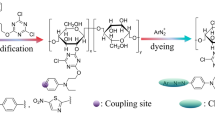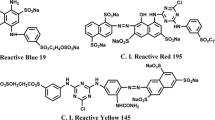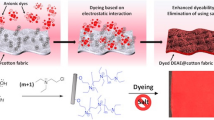Abstract
This article presented an innovative amino modification of cotton fabric using 2-chloro-4,6-diamino-1,3,5-triazine (CDATA, the intermediate of reactive dyes). The horseradish peroxidase enzyme (HRP)/H2O2 system was used to catalyze the grafting and polymerization of CDATA modified cotton fabrics and Catechol (CA). The amino group content of modified cotton fabric was successfully verified using Raman spectroscopy, energy dispersive spectroscopy, and high-performance liquid chromatography—mass spectrometry, and the amino content was about 2.09−3mmol/g. Response surface methodology was employed to optimize the dyeing process with four factors: H2O2 dosage, CA dosage, HRP dosage, and pH of buffer solution. Under the optimized process, the K/S value of the dyed fabrics could reach 10.0, exhibiting high color depth, dyeing uniformity, and friction fastness. The grafting chain structure of CA was controlled through L-ascorbic acid, which gave the fabric different colors and improved the dyeing performance and color fastness of CA. Finally, the covalent binding mechanism between CA and amino-modified cotton fabrics was explored. Research has found that the amino groups of cotton fibers react with the reactive groups of CA to form covalent bonds, thereby improving dyeing performance and color fastness.













Similar content being viewed by others
Data availability
All data generated or analysed during this study are included in this article.
References
Ayele M, Tesfaye T, Alemu D, Limeneh M, Sithole B (2020) Natural dyeing of cotton fabric with extracts from mango tree: A step towards sustainable dyeing. Sustain Chem Pharm 17:100293. https://doi.org/10.1016/j.scp.2020.100293
Baek N-W, Lou J-F, Wang J, Fan X-R (2022a) Horseradish Peroxidase-Catalyzed Coloration of Natural Phenols on Silk Fabric: Effects of Various Buffer Systems and pH Value on Dyed Color. J Nat Fib 19(16):13155–13166. https://doi.org/10.1080/15440478.2022.2086197
Baek NW, Fan XR, Zhang X, Wang D, Yuan JG (2022b) Horseradish Peroxidase-catalyzed “Template” Polymerization of Gallic Acid for the Functionalization of Silk Fabrics. J Nat Fib 19(14):9486–9499. https://doi.org/10.1080/15440478.2021.1982836
Chairat M, Darumas U, Bremner JB, Bangrak P (2011) Dyeing of cotton yarn with the aqueous extract of the leaves of Eupatorium odoratum L. in Thailand and associated extract toxicity studies. Coloration Technol 127(5):346–353. https://doi.org/10.1111/j.1478-4408.2011.00321.x
Dulo B, Phan K, Githaiga J, Raes K, De Meester S (2021) Natural Quinone Dyes: A Review on Structure, Extraction Techniques, Analysis and Application Potential. Waste Biom Valor 12(12):6339–6374. https://doi.org/10.1007/s12649-021-01443-9
Dulo B, De Somer T, Phan K, Roosen M, Githaiga J, Raes K, De Meester S (2022) Evaluating the potential of natural dyes from nutshell wastes: Sustainable colouration and functional finishing of wool fabric. Sustain Mater Technol 34:e00518. https://doi.org/10.1016/j.susmat.2022.e00518
El-Zawahry MM, El Khatib HS, Shokry GM, Rashad HG (2022) One-Pot Robust Dyeing of Cotton Fabrics with Multifunctional Chamomile Flower Dyes. Fib Polym 23(8):2234–2249. https://doi.org/10.1007/s12221-022-4206-0
Garg H, Singhal N, Singh A, Khan MD, Sheikh J (2023) Laccase-assisted colouration of wool fabric using green tea extract for imparting antioxidant, antibacterial, and UV protection activities. Environ Sci Pollut Res 30(35):84386–84396. https://doi.org/10.1007/s11356-023-28287-1
Habib N, Adeel S, Ali F, Amin N, Khan SR (2021) Environmental friendly sustainable application of plant-based mordants for cotton dyeing using Arjun bark-based natural colorant. Environ Sci Pollut Res 28(38):54041–54047. https://doi.org/10.1007/s11356-021-14536-8
Hu RZ, Zhang ZF, Yu BQ, Wang J, Yao XH, Chen T., . . . Zhang DY (2022). Natural phenolics and flavonoids modified the hierarchical cellular cellulose sponges for efficient water disinfection. Carbohydr Polym. 296:119962. https://doi.org/10.1016/j.carbpol.2022.119962.
Indrianingsih AW, Rosyida VT, Darsih C, Apriyana W (2021). Antibacterial activity of Garcinia mangostana peel-dyed cotton fabrics using synthetic and natural mordants. Sustainable Chemistry and Pharmacy, 21. https://doi.org/10.1016/j.scp.2021.100440.
Jia W, Wang Q, Fan X, Dong A, Yu Y, Wang P (2017) Laccase-mediated in situ oxidation of dopa for bio-inspired coloration of silk fabric. RSC Adv 7(21):12977–12983. https://doi.org/10.1039/c6ra25533g
Khatun MH, Mostafa MG (2022). Optimization of Dyeing Process of Natural Dye Extracted from Polyalthia longifolia Leaves on Silk and Cotton Fabrics. J Nat Fib. 1–16. https://doi.org/10.1080/15440478.2022.2081281.
Kim S, Moldes D, Cavaco-Paulo A (2007) Laccases for enzymatic colouration of unbleached cotton. Enzyme Microb Technol 40(7):1788–1793. https://doi.org/10.1016/j.enzmictec.2007.01.002
Kumaresan M (2021). Application of Eco-Friendly Natural Dye on Cotton Obtained from the Flower of Opuntia ficus-indica Using Combination of Mordants. Nat Environ Poll Technol 20(2) https://doi.org/10.46488/NEPT.2021.v20i02.033.
Liu J, Pu H, Chen C, Liu Y, Bai R, Kan J, Jin C (2018) Reaction Mechanisms and Structural and Physicochemical Properties of Caffeic Acid Grafted Chitosan Synthesized in Ascorbic Acid and Hydroxyl Peroxide Redox System. J Agric Food Chem 66(1):279–289. https://doi.org/10.1021/acs.jafc.7b05135
Pan H, Zhao T, Xu L, Shen Y, Wang L, Ding Y (2020) Preparation of novel chitosan derivatives and applications in functional finishing of textiles. Int J Biol Macromol 153:971–976. https://doi.org/10.1016/j.ijbiomac.2019.10.226
Panzella L (2020). Natural Phenolic Compounds for Health, Food and Cosmetic Applications. Antioxidants (Basel), 9(5). https://doi.org/10.3390/antiox9050427.
Pisitsak P, Tungsombatvisit N, Singhanu K (2018) Utilization of waste protein from Antarctic krill oil production and natural dye to impart durable UV-properties to cotton textiles. J Clean Prod 174:1215–1223. https://doi.org/10.1016/j.jclepro.2017.11.010
Rahman MM, Koh J, Hong KH (2022) Coloration and multi-functionalization of cotton fabrics using different combinations of aqueous natural plant extracts of onion peel, turmeric root, and pomegranate rind. Ind Crops Prod 188:115562. https://doi.org/10.1016/j.indcrop.2022.115562
Rehan M, Abdel-Wahed NAM, Farouk A, El-Zawahry MM (2018) Extraction of Valuable Compounds from Orange Peel Waste for Advanced Functionalization of Cellulosic Surfaces. ACS Sustain Chem Eng 6(5):5911–5928. https://doi.org/10.1021/acssuschemeng.7b04302
Ribeiro JS, Veloso CM (2021) Microencapsulation of natural dyes with biopolymers for application in food: A review. Food Hydrocolloids 112:106374. https://doi.org/10.1016/j.foodhyd.2020.106374
Romdhani Z, Sakji N, Hamdaoui M (2022) Eco-Friendly Dyeing of Wool Fabrics with Natural Dye Extracted from Citrus Sinensis L Peels. Fib Polym 23(6):1621–1630. https://doi.org/10.1007/s12221-022-4478-4
Sun X, Bai R, Zhang Y, Wang Q, Fan X, Yuan J., . . . Wang P (2013). Laccase-Catalyzed Oxidative Polymerization of Phenolic Compounds. App Biochem Biotechnol. 171(7):1673–1680. https://doi.org/10.1007/s12010-013-0463-0.
Yaglıoglu AS, Eser F, Dolarslan M (2022) Phenolic Compounds, Dyeing Potential, and Cytotoxic Activity ofAlkanna orientalisL. Boiss (Boraginaceae). AATCC J Res 9(2):106–114. https://doi.org/10.1177/24723444221081464
Zhao Z, Yan C, Xu F, Liu J (2023) Study on Dyeing Properties and Color Characteristics of Wool Fabrics Dyed with Geranium caespitosum L. Extract—A New Natural Yellow Dye. Coatings 13(6):1125. https://doi.org/10.3390/coatings13061125
Funding
This work was financially supported by the Natural Science Foundation of Jiangsu Province, China (Grants No. BK 20231054).
Author information
Authors and Affiliations
Contributions
All authors contributed to the study. Lou J and Sun R.. wrote the main manuscript text and supervised it, Yuan J. and Xu J. contributed to the methodology and investigation, Fan X. and Gu Z. reviewed the manuscript and commented them. All authors reviewed the manuscript.
Corresponding authors
Ethics declarations
Competing interests
The authors declare no competing interests.
Ethical approval
No animal or human studies were carried out by the authors.
Conflict of interest
The authors declare no potential conflict of interest.
Additional information
Publisher's Note
Springer Nature remains neutral with regard to jurisdictional claims in published maps and institutional affiliations.
Rights and permissions
Springer Nature or its licensor (e.g. a society or other partner) holds exclusive rights to this article under a publishing agreement with the author(s) or other rightsholder(s); author self-archiving of the accepted manuscript version of this article is solely governed by the terms of such publishing agreement and applicable law.
About this article
Cite this article
Lou, J., Sun, R., Yuan, J. et al. In-situ polymerization, colorization, and functionalization of amino-modified cotton fabrics with Catechol via horseradish peroxidase-hydrogen peroxide system. Cellulose (2024). https://doi.org/10.1007/s10570-024-05859-z
Received:
Accepted:
Published:
DOI: https://doi.org/10.1007/s10570-024-05859-z




